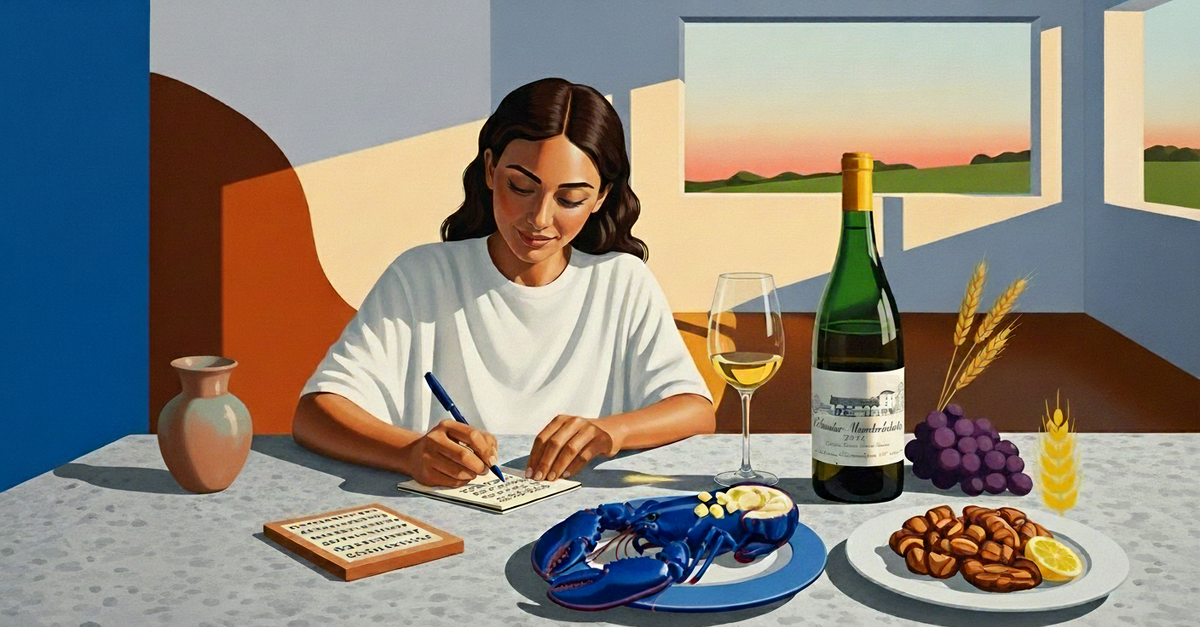Lanterns on Limestone: Domaine d’Auvenay Chevalier-Montrachet 2014
Domaine d’Auvenay Chevalier-Montrachet 2014 food pairing: from Breton blue lobster and verjus to salsify meunière, Bresse chicken, and salt-baked celery root.

I pour and the bowl catches pale straw like a lantern cupped against night. The first breath is reticent—lemon skin, white almond, wet chalk—then a thread of smoke, the shy ghost of oak. I give it a soft splash-decant, enough air to wake the stone but not rouse the sea, and I start it cool, 11–12 °C, letting it wander toward 14 °C as the voice grows. In a wide Burgundy tulip the wine gathers and lengthens; such glassware coaxes altitude and limestone as surely as a hand on a harp string.
France, Burgundy: Chevalier-Montrachet rides the crest above Puligny, a crown of thin soils over hard limestone. Here Chardonnay is shaped by wind and evening cold, by drainage that makes roots travel and berries stay small. The bottle bears the hand of Domaine d’Auvenay—Lalou Bize-Leroy’s perfectionist chapel—where attentive farming and minute yields translate slope into syllables. The climate’s cool nights steady the ripening; the stony ground edits excess. Chardonnay is the principal grape; the idiom is precision.
The 2014 vintage speaks in bright ink. Acidity draws a chalk line down the palate, knitting citrus to white peach, crushed fennel to almond skin. Texture is silk on bone—supple yet tensile—with a faint pith that keeps luxury in check. Oak whispers spice and heat-polished hazelnut, then erases its footprints. The finish is saline and long, like memory returning in small, lucid waves. In such wines I hear my old work—the keeper of seasons and endings—repaid with beginnings in the glass: renewal on the tongue.
Salt, fat, and the grammar of light
Chevalier’s power is not weight but radiance. High natural acidity—the mouth-watering pull that cleans the palate—loves butter’s gloss, while the wine’s lack of grippy tannin (tannin being the gentle drying grip you feel in strong tea) keeps umami from turning bitter. A hint of smoke courts char; citrus tone invites zest and verjus. Salt is the tuning fork. Choose dishes that let light travel through fat.
Altars of feather and shell
For a classic rendered specific, think Bresse chicken roasted on the carcass and finished with a glaze of reduced chicken jus and a last-minute beurre noisette scented with lemon thyme. The lacquered skin mirrors the wine’s toasted hush; the jus meets its almond note; acidity lifts every bite until the bones show clean. From the sea, Breton blue lobster poached gently in butter, then painted with a restrained shellfish reduction sharpened by verjus, echoes Chevalier’s sweet-saline finish without crowding it. The gelatin in lobster meets the wine’s silk; the verjus answers its citrus line.
Pilgrimages a little farther afield
Take Hokkaido scallops and sear them fast in browned butter; deglaze with a breath of sake and a squeeze of sudachi. The scallops’ sweetness mirrors orchard fruit, while the sake’s rice umami finds no resistance in a white with low tannin; sudachi threads the citrus seam. Or go landward: veal sweetbreads crisped until the shell fractures, set on celery-root purée, finished with a white-wine reduction and preserved lemon. Texture speaks to texture; brightness keeps the custard-rich center buoyant, and the lemon’s salt preserves the wine’s mineral grammar.
I have known this grammar since vines first learned my name. I descended each autumn to tally harvests; I rise each spring when sap starts its quiet climb. In such work, one learns to match light to substance.
Vegetables in their ceremonial dress
Salt-baked celery root carved in steaming slabs, glossed with hazelnut brown butter and a handful of chives, lets the wine’s almond and smoke step forward without heaviness. The root’s sweetness sweetens mineral edges; the butter gives the glide. Or consider a sunchoke risotto—no cream, just slow, starchy emulsion—finished with aged Parmesan and a trickle of chicken reduction. Here the wine’s acidity is the metronome, keeping each spoonful articulate, never slurred.
Little devotions on the side
Salsify à la meunière, batons browned in butter and flicked with lemon and parsley, is a near-perfect echo chamber: nuttiness, citrus, and a tender bite meeting silk, salt, and stone. A celery-root mille-feuille—paper-thin layers baked with a veil of Comté—offers crisp edges for the wine’s smoky toast, and a soft interior for its glide. When the table reaches for a closing chord, turn from sugar to cheese: a 30–36 month Comté or Beaufort d’été, their caramel and hazelnut tones widening the wine’s almond skin into something like dusk. Sweet desserts would make the finish seem sharp; savory endings keep the light warm.
If you hold this bottle now, decant with a gentle hand for twenty to thirty minutes and give it the space of a broad bowl. Serve cool and unhurried; let conversation and temperature rise together. The 2014 is vivid today, and it will deepen—wax and honey, brioche and warm stone—through the late 2030s. I bless it as I once blessed harvests: a quiet benediction to limestone, to patience, to dinners that feel like kept promises. Meet me where the lamp’s circle meets the rim of the glass; I will be there, counting heartbeats between sips, guarding the grammar of light.





